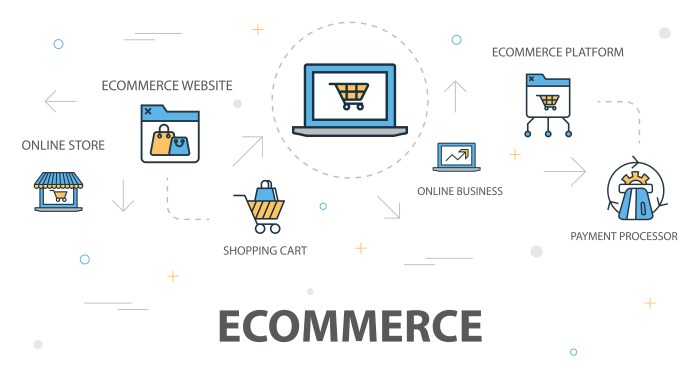E-commerce platforms are the heartbeat of online business, fueling success and growth in the digital marketplace. From defining their significance to exploring customization and design, these platforms play a crucial role in shaping the online shopping experience. Dive into the world of e-commerce platforms and discover how they revolutionize the way businesses operate and thrive in the digital landscape.
Overview of E-Commerce Platforms
E-commerce platforms play a crucial role in the digital marketplace by providing businesses with the tools and technology needed to sell products or services online. These platforms enable online transactions, streamline operations, and enhance customer experience.
Types of E-Commerce Platforms
- Open-Source Platforms: These platforms are customizable and allow businesses to have full control over their online store’s design and functionality.
- Hosted Platforms: Hosted platforms are easy to set up and maintain as the hosting and technical aspects are managed by the platform provider.
- Cloud-Based Platforms: Cloud-based platforms offer scalability and flexibility, allowing businesses to adjust their online store according to changing needs.
Key Features of E-Commerce Platforms
- Mobile Responsiveness: E-commerce platforms are designed to be mobile-friendly, ensuring a seamless shopping experience for customers on smartphones and tablets.
- Payment Gateway Integration: These platforms support various payment options, making it convenient for customers to make purchases online.
- Inventory Management: E-commerce platforms help businesses manage their inventory levels, track stock, and automate reordering processes.
- Optimization: E-commerce platforms come with built-in tools to improve search engine visibility and drive organic traffic to the online store.
Popular E-Commerce Platforms
When it comes to e-commerce platforms, there are several popular options that businesses globally rely on to power their online stores. Each platform comes with its own set of features, pricing models, and scalability options, making it essential for businesses to choose the right one based on their specific needs and goals.
Shopify
Shopify is one of the most widely used e-commerce platforms, known for its user-friendly interface and extensive customization options. It offers various pricing plans based on the size of the business and provides scalability as the business grows. Many successful businesses, such as Gymshark and MVMT, have built their online stores using Shopify.
WooCommerce
WooCommerce is a popular e-commerce plugin for WordPress websites, offering a flexible and customizable solution for businesses of all sizes. It is known for its easy integration with WordPress and provides various extensions for additional features. Successful businesses like Allbirds and WP Standard utilize WooCommerce for their online stores.
Magento, E-commerce platforms
Magento is a robust e-commerce platform that caters to large enterprises and businesses with complex needs. It offers advanced features for customization, scalability, and integration with other systems. Companies like Coca-Cola and Ford utilize Magento for their e-commerce operations.
BigCommerce
BigCommerce is a scalable e-commerce platform that caters to businesses looking to grow rapidly. It offers various pricing plans with no transaction fees and provides advanced features like multi-channel selling and marketing tools. Successful businesses such as Ben & Jerry’s and Skullcandy use BigCommerce for their online stores.
Customization and Design
In the world of e-commerce, customization and design play a crucial role in the success of online platforms. Let’s dive into why they are so important and how businesses can make the most of them.
Importance of Customization in E-Commerce Platforms
Customization in e-commerce platforms is essential for branding and creating a unique user experience. By customizing their platforms, businesses can establish a strong brand identity and differentiate themselves from competitors. This helps in building trust with customers and increasing brand loyalty.
- Customization allows businesses to tailor the look and feel of their online store to align with their brand image.
- Personalized product recommendations and content can enhance the user experience and increase customer engagement.
- Customizing the checkout process can reduce cart abandonment rates and improve conversion rates.
Best Practices for Designing User-Friendly Interfaces
Creating a user-friendly interface is key to ensuring a positive shopping experience for customers. Here are some best practices for designing interfaces on e-commerce platforms:
- Keep the design clean and clutter-free to make navigation easy for users.
- Use high-quality images and visuals to showcase products effectively.
- Optimize the platform for mobile devices to cater to the growing number of mobile shoppers.
- Implement intuitive search and filtering options to help customers find products quickly.
Personalizing E-Commerce Platforms to Stand Out
To stand out from competitors, businesses can personalize their e-commerce platforms in various ways:
- Send personalized recommendations based on customer browsing and purchase history.
- Offer customization options for products to allow customers to create unique items.
- Use targeted marketing campaigns to reach specific customer segments with relevant offers.
- Create a loyalty program that rewards customers for their repeat purchases and engagement with the platform.
Payment Gateways and Security

Payment gateways play a crucial role in e-commerce platforms by acting as the intermediary between the customer and the merchant during online transactions. These gateways securely authorize payments, ensuring that sensitive information such as credit card details are encrypted and protected.
Importance of Secure Payment Options
- Integrating secure payment options is essential for building trust with customers. When shoppers feel that their financial information is safe, they are more likely to make purchases on the platform.
- Secure payment options also help in reducing the risk of fraud and chargebacks, providing a seamless and reliable shopping experience for users.
Security Measures in E-Commerce Platforms
- SSL Encryption: E-commerce platforms use SSL (Secure Socket Layer) encryption to protect data transmitted between the customer’s browser and the server, ensuring that sensitive information is encrypted and secure.
- PCI DSS Compliance: Platforms adhere to Payment Card Industry Data Security Standard (PCI DSS) requirements to safeguard cardholder data and prevent data breaches.
- Two-Factor Authentication: Implementing two-factor authentication adds an extra layer of security by requiring users to provide two forms of identification before accessing their accounts.
- Tokenization: Tokenization replaces sensitive data such as credit card numbers with unique tokens, minimizing the risk of data theft during transactions.
Mobile Commerce Integration

Mobile commerce integration is crucial in today’s digital landscape, with more and more consumers using their smartphones and tablets to shop online. Ensuring that e-commerce platforms are optimized for mobile devices is essential to provide a seamless shopping experience for users on the go.
Importance of Mobile Responsiveness
- Mobile responsiveness ensures that e-commerce platforms adapt to different screen sizes and resolutions, providing a consistent user experience across devices.
- Optimizing for mobile devices can lead to higher conversion rates and lower bounce rates, as users are more likely to make purchases on a mobile-friendly platform.
- Google prioritizes mobile-friendly websites in search results, improving visibility and driving more traffic to e-commerce platforms.
Strategies for Optimizing E-Commerce Platforms for Mobile Devices
- Implement responsive web design to ensure that the layout and content of the e-commerce platform adjust dynamically based on the device being used.
- Optimize images and videos for fast loading times on mobile devices, reducing bounce rates and improving user experience.
- Simplify the checkout process for mobile users by reducing the number of steps required to complete a purchase and offering mobile payment options.
Examples of Successful Mobile Commerce Integration
- Amazon: The e-commerce giant has a mobile app that offers a seamless shopping experience with features like one-click ordering and personalized recommendations.
- Shopify: This e-commerce platform provides mobile-responsive themes and a mobile app for managing online stores on the go.
- Etsy: The online marketplace for handmade and vintage goods has a mobile app that allows users to browse and purchase products easily from their smartphones.
Analytics and Performance Tracking: E-commerce Platforms
In the world of e-commerce, analytics tools play a crucial role in measuring the performance of online platforms. By tracking various metrics, businesses can gain valuable insights into the effectiveness of their strategies and make data-driven decisions to improve their online sales.
Key Metrics for Evaluation
- Conversion Rate: This metric measures the percentage of website visitors who make a purchase. A high conversion rate indicates that your platform is effectively converting visitors into customers.
- Cart Abandonment Rate: This metric shows the percentage of users who add items to their cart but do not complete the purchase. A high abandonment rate may indicate issues with the checkout process.
- Customer Acquisition Cost (CAC): CAC measures how much it costs to acquire a new customer. Monitoring this metric helps businesses optimize their marketing spend.
- Average Order Value (AOV): AOV represents the average amount spent by customers in a single transaction. Increasing AOV can boost revenue and profitability.
Using Analytics Data for Decision Making
Analytics data can provide businesses with valuable insights that can lead to improved performance. By analyzing customer behavior, trends, and preferences, businesses can tailor their marketing strategies, optimize product offerings, and enhance the overall user experience. With the help of analytics tools, businesses can make informed decisions to drive growth and increase online sales.

